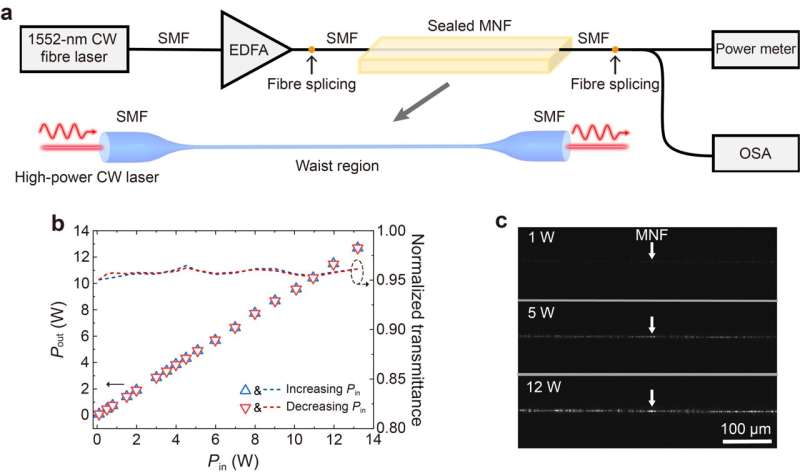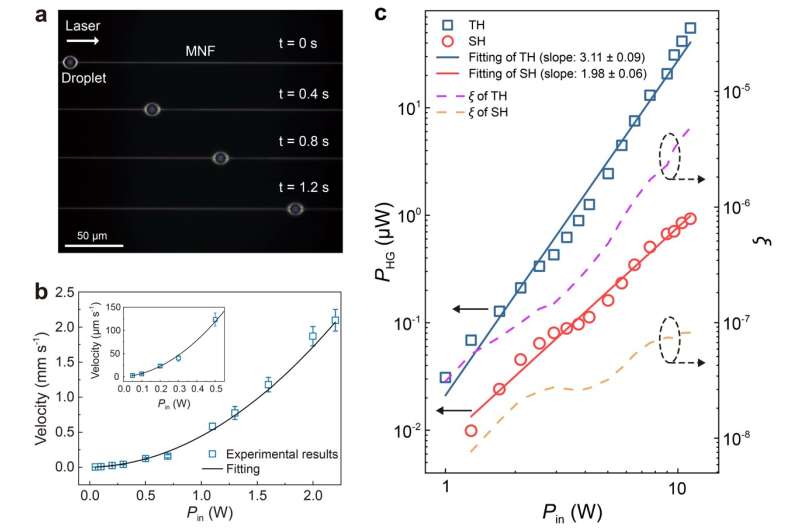This article has been reviewed according to Science X's editorial process and policies. Editors have highlighted the following attributes while ensuring the content's credibility:
fact-checked
peer-reviewed publication
trusted source
proofread
High-power optical continuous-wave waveguiding in a silica micro/nanofiber

Optical MNFs are cylindrical optical waveguides with diameter below or close to the wavelength of the light. Since its first experimental demonstration, low-loss silica MNF has been attracting increasing attention in wide applications from optical sensors, atom optics, nonlinear optics to optomechanics.
Generally, increasing the waveguiding mode power is the most effective approach to enhance light-matter interaction, and explore new opportunities for both scientific research and technological applications. However, the highest CW mode power reported so far in a MNF is ~0.4 W, with typical waveguiding power below 0.1 W (in CW or averaged power). Also, the optical damage threshold, or equivalently, how much power can a MNF transmit remains unknown.
In a new paper published in Light Science & Application, a team of scientists, led by Prof. Limin Tong and Assoc. Prof. Xin Guo from Zhejiang University, China, and Dr. Yuhang Li from Tsinghua University, China, have demonstrated high-power CW optical waveguiding in an optical MNF around 1,550-nm wavelength with power up to 13 W, which is more than 30 times higher than the highest power reported before.
They show that when waveguiding such high-power CW, the MNF remains at high optical transmittance (> 95%), without predominant single scattering spots on the fiber surface. In practice, the MNF can safely handle a CW power higher than 10 W without observable degradation with accumulated operation time of more than 10 hours in a two month test. Based on the absorption-induced thermal effect, they predict an optical damage threshold higher than 70 W (in CW power) in a single MNF in air.
To show the extraordinary ability of a high-power waveguiding MNF, the team demonstrate high-speed optomechanical driving of a microdroplet (10 μm in size) in the air. The measured power-dependent droplet velocity vo (e.g., vo = 2.1 mm s-1 at a waveguided power of 2.2 W) shows that the droplet can be driven more than 10 times faster than those reported in previous MNF-based optomechanics systems.

Also, the team realize intermodal-phase-matched second harmonic generation with efficiency higher than those pumped by short pulses and third harmonic generation with efficiency falling in the range of typical results reported previously using short pulses.
"The extraordinary CW conversion efficiency comes from combined factors of high waveguiding power, perfectly matched phase and relatively large interaction length. As the power we used here is lower than the optical damage threshold (70 W), the nonlinear frequency conversion efficiency could be even higher when higher CW waveguiding power is available," they add.
"As CW waveguiding is desired in a variety of MNF-based applications, our results may extend MNF optics into high-power region, and open up new opportunities for MNF-based technology ranging from fiber laser, nonlinear conversion, optomechanics to biophotonics and atom optics," the scientists suggest.
More information: Jianbin Zhang et al, High-power continuous-wave optical waveguiding in a silica micro/nanofibre, Light: Science & Applications (2023). DOI: 10.1038/s41377-023-01109-2
Journal information: Light: Science & Applications
Provided by Chinese Academy of Sciences





















